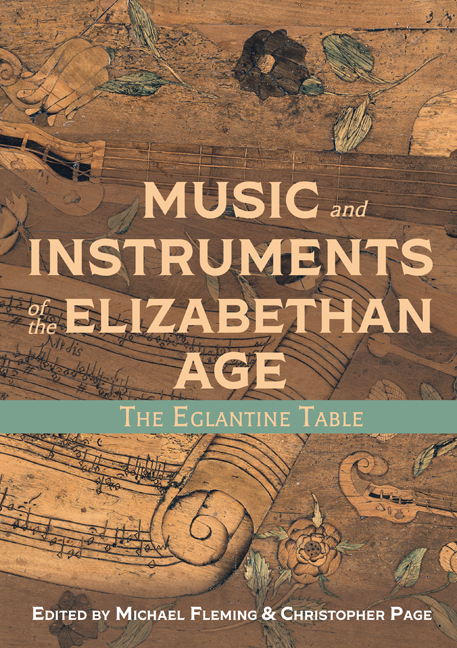Book contents
- Frontmatter
- Dedication
- Contents
- List of Illustrations
- Foreword
- Acknowledgements
- Note to the Reader
- List of Abbreviations
- Introducing the Eglantine Table
- Part I Silent Things
- Part II Music and Instruments
- Part III Broader Views of the Eglantine Table
- Appendices
- Glossary
- Bibliography
- List of Contributors
- Index
- Plate section
Appendix 2 - The Table in the Context of Furnishings in Bess of Hardwick’s Houses
Published online by Cambridge University Press: 24 March 2021
- Frontmatter
- Dedication
- Contents
- List of Illustrations
- Foreword
- Acknowledgements
- Note to the Reader
- List of Abbreviations
- Introducing the Eglantine Table
- Part I Silent Things
- Part II Music and Instruments
- Part III Broader Views of the Eglantine Table
- Appendices
- Glossary
- Bibliography
- List of Contributors
- Index
- Plate section
Summary
The sixteenth-century furniture at Hardwick Hall was probably made or acquired for Chatsworth, where the Eglantine Table (late 1560s; NT 112774) would have complemented the other marquetry furniture, some of it French, and the extensive marquetry panelling. In 1601 Chatsworth's ‘high gallerie’ was ‘verie fayre waynscotted with couloured woodes markentrie & pelasters fayre set foorth’, and seven other rooms were decorated with inlaid woodwork, whereas the coeval Hardwick inventory reveals that there the focus was upon tapestries and wall-hangings. Even so, there were thirty-seven pieces of inlaid furniture at Hardwick, some ‘Carved guilt and inlayde’, including ‘court’ cupboards, tables, chairs, stools, bedheads and bedposts. The contemporary fashion for marquetry is also reflected in the 1590 inventory of Lumley Castle, drawn up for John, Lord Lumley (c1533–1609), which listed twenty-three ‘Bed steades’, seventeen chairs, fifty-seven stools, twenty-five tables and eight cupboards ‘of walnuttre and Markatre’.
Bess's improvements at Chatsworth, undone by the 4th Earl of Devonshire (the 1st Duke) in the 1690s, are commemorated in a tent-stitch cushion-cover depicting the facade or ‘platt of Chatesworth house’, one of 18 ‘long quitions’ listed in 1601 ‘for the windowes’ in the Long Gallery at Hardwick. There were no fewer than 142 embroidered cushions listed in Bess's three principal houses in 1601, of which ninety-two were in the New Hall.
Woodwork translated to Hardwick from Chatsworth presumably includes four large landscape-shaped inlaid panels (NT 1127974). One, dated 1576, depicts an idealised townscape deriving from a print by Hans Vredeman de Vries (1526–c1604), whose comparable design of 1580 was the model for the central panel of an inlaid oak door from Antwerp Town Hall, attributed to the civic cabinet-maker Pieter van Geelbeke, now in the Victoria and Albert Museum, London. The Antwerp scheme may have been the prime inspiration for the four Hardwick panels, and Anthony Wells-Cole shows in Chapter 1 how the influence of Vredeman de Vries may extend to the Eglantine Table.
- Type
- Chapter
- Information
- Music and Instruments of the Elizabethan AgeThe Eglantine Table, pp. 240 - 245Publisher: Boydell & BrewerPrint publication year: 2021



